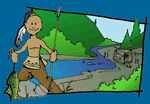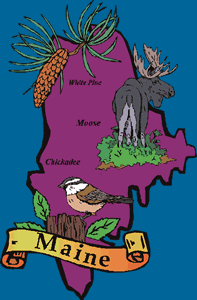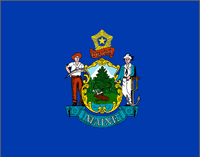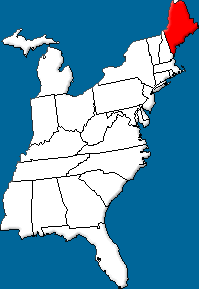


Geography and Landforms:
Maine is the largest of the New England states of the northeastern United States. It is bordered by New Hampshire to the West, the Canadian provinces of Quebec and New Brunswick to the northwest and northeast, the Atlantic Ocean to the southeast, and the Bay of Fundy to the east.
The last ice age had a profound effect on the geography of Maine. A glacier was responsible for carving out the many inlets and bays for which the state is famous.
|
 History:
Vikings, led by Leif Ericson, were probably the first Europeans to visit Maine around the year 1000 AD. In 1448, John Cabot, an Italian explorer in the service of England, reached the Maine coast. France sent many explorers during the 16th and early 17th century, but no official settlement was made until 1607 when King James I of England awarded a grant to the Plymouth Company for the establishment of Fort St. George on the site of present day Phippsburg. The settlement did not prosper and colonists returned to England one year later.
|
 Economy:
Maine has a wealth of natural resources that support a large part of the state's economy. Nearly 89% of Maine's land area is covered by forest. As a result, the state is one of the world's leading producers of paper products. Mineral deposits within the state include granite (used for construction throughout the United States), sand and gravel, and zinc.
|
 First Inhabitants:
The earliest inhabitants of what is now the state of Maine descended from Ice Age hunters. They were called the Red Paint People because of the red clay they used to line the graves of their dead. Little is known about this prehistoric group of people, but they left behind scattered bits of bone and stone that are among the oldest archeological treasures in North America.
|
Books Related To MaineBirdie's Lighthouse - Deborah Hopkinson The Canning Season - Polly Horvath Converting Kate - Beckie Weinheimer Fudge-A-Mania - Judy Blume L is for Lobster: A Maine Alphabet - Cynthia Furlong Reynolds May - Kathryn Lasky One Morning in Maine - Robert McCloskey Sand Dollar Summer - Kimberly Jones The Sign of the Beaver - Elizabeth George Speare The White Wolf - Ron Roy |
Famous Citizens:
|
| Capital: | Augusta |
| Entered Union: | March 15, 1820 |
| Population: | 1,333,089 |
| Area | 35,385 |
| Bird | Chickadee |
| Flower | White pine cone and tassel |
| Nickname: | Pine Tree State |
| Governor | Paul LePage |
Places to Visit in Maine: (Click the links to learn more.)
|



